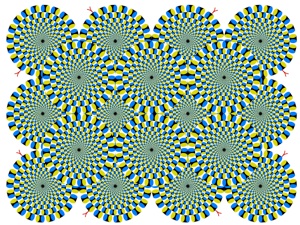Motion perception
This is useful, of course, for navigation, tracking, manipulation, and object recognition. Sometimes motion by itself is sufficient to allow you to recognize an object, even when its camouflage is otherwise perfect, as in this ‘hidden bird’ example:
Reichardt worked out a very simple little circuit for computing motion, it is called a Reichardt detector.
reichardbell.mov (download and play with quicktime)
This detector makes some very straightforward predictions, for instance that you won’t be able to distinguish ‘real’ from ‘apparent motion’
see bistable apparent motion demo
There are also motion ‘aftereffects’, where adaptation (prolonged exposure) to one type of motion creates a bias to see the ‘opposite’ type of motion:
27. Motion perception
1:15 PM
Motion perception allows you to note - automatically and effortlessly - when an object or region of the scene has changed positions, that is, moved from one location to another, over time.
...and we also clearly have special purpose motion detectors, just as we had special purpose detectors for things like human faces:
This is ‘biological motion’ - you are very good at extracting information from such stimuli... check it out for yourself here:


